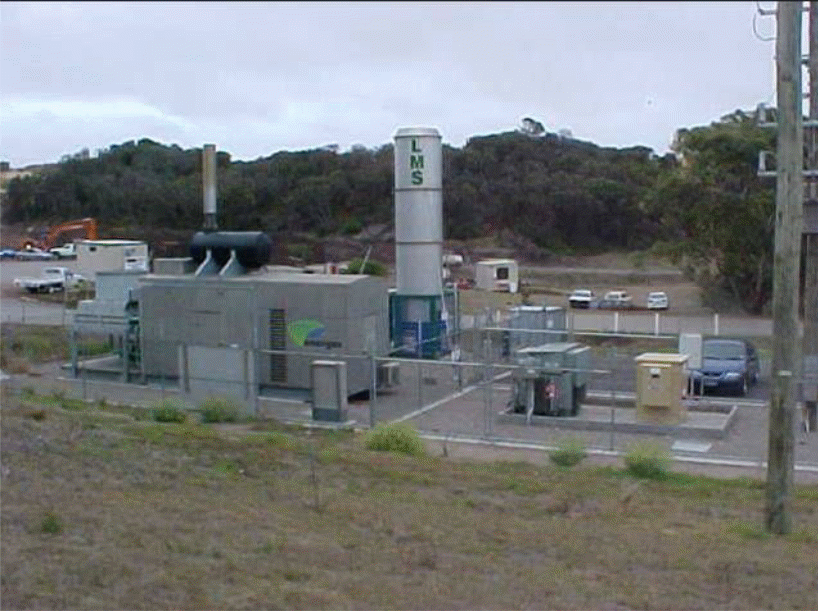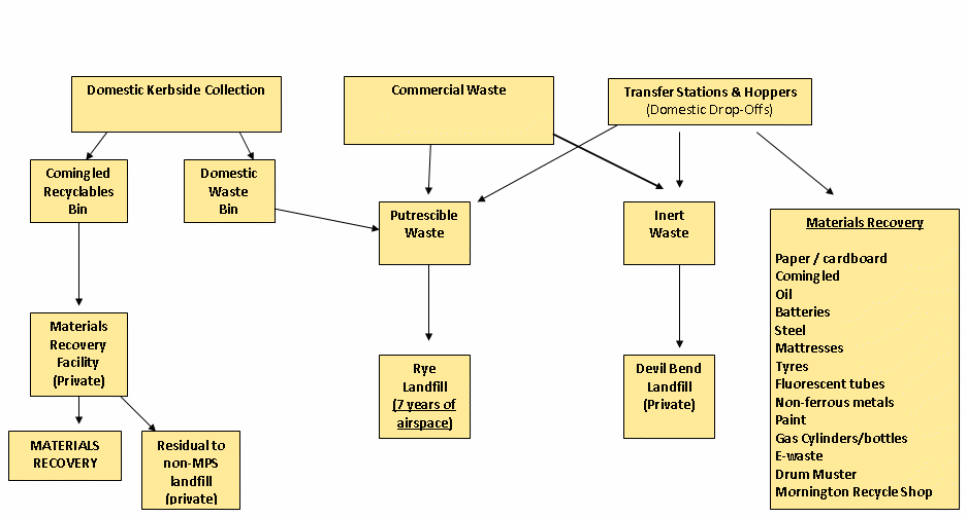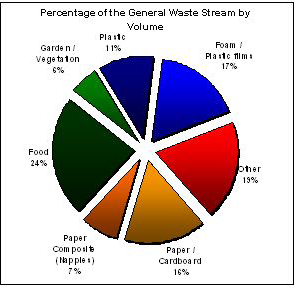Executive Summary
Waste materials from the domestic and commercial sector pose various challenges to the environment. They also inflate domestic and organisational budgets. This paper discusses the challenges of waste management with reference to Rye Waste Management Facility. The facility is located is situated in Australia within Mornington Peninsula, Shire municipality.
The facility receives MSW from both domestic and commercial sectors. It has systems of waste management involving recycling and composting green wastes. Above 50% of wastes received at Rye facility comprises green wastes from commercial and domestic sources.
Therefore, two cost saving opportunities are recommended. The first opportunity involves a reduction of pre-consumption green wastes while the second is a reduction of post-consumption wastes including biodegradable and non-biodegradable wastes.
Introduction
Increasing urban population causes an alarming increase in waste material production. World Bank (2013) confirms the severity of solid wastes in urban areas by claiming that urban centres had about 2.9 billion people ten years ago, with each person producing an average of 0.64 kg of MSW (municipal solid waste) per day. This figure amounts to about 0.68 billion tonnes of MSW annually.
With the onset of the high increase in the consumption of mass-produced manufactured products, the urban population has not only increased currently. Waste production per individual urban resident has also increased. World Bank (2013) reveals that the population of urban centre residents is about 3 billion, with each person producing about 1.2 kg of waste materials on a daily basis.
Upon projecting these statistics in 10 years to come, by 2025, the world urban population will have grown to about 4.3 billion with a corresponding increase of wastes production of up to 1.42 kg per individual on a daily basis. This situation will amount to close to 2.2 billion tonnes of MSW annually.
To mitigate this challenge, urban centres need to reduce this amount of waste production while incorporating appropriate strategies for effective waste management within their waste management facilities. This paper discusses how this goal can be achieved with reference to Rye waste management facility in Australia.
Background Information
Rye is one of the Mornington Peninsula Shire municipality landfills. Landfills are “used for waste management purposes such as temporary storage, consolidation and transfer, or processing of waste materials” (Diaz, Chiumenti, Savage & Eggerth 2003, p.52).
For instance, Rye receives different kinds of wastes. When sorted out, green waste is transferred to the unit for composting and production of methane gas, which is burnt to produce heat energy. This energy produces electrical energy, which serves 1500 homes.
After composting, mulch is produced and later sold within the municipality. At Rye facility also has a waste transfer station, namely Truemans Road Transfer Station.
The main aim of Rye facility is to foster waste recovery together with the provision of tipping services to people within the municipality. It provides people, especially Kerbside residents, with easy, cost effective, and quick means of disposing their domestic and commercial wastes.
Demographic Data
Rye landfill accepts putrescible and landfill wastes. It also receives domestic together with commercial wastes from Kerbside. Putrescible wastes refer to “solid wastes that contain organic matter that is capable of being decomposed by microorganisms and of such a character and proportion as to cause obnoxious odours” (Price 2001, p.334).
Various cells for the Rye wastes disposal facility are already filled with substantive amount of waste products. This situation has prompted the establishment of the final cell with an approximated life span of 7 years if waste disposal rates do not increase from the current rates.
The cell has an airspace of 800, 000 M3 (Mornington Peninsula Shire 2009). Both Rye and Tyabb process about 151, 200 M3 of green wastes per year (Mornington Peninsula Shire 2009).
Mornington Peninsula Shire municipality receives various types of wastes. The wastes fall into three categories. The first category comprises MSW while the second category consists of organics. The third category consists of recovered materials. 54-percent (81,274 tonnes) of all the wastes received by the municipality predominantly comprises the MSW (Mornington Peninsula Shire 2009).
Moreover, 26-percent (37,800) of the waste materials contain green wastes while the recovered material constitutes 18-percent or 28, 222 tonnes (Mornington Peninsula Shire 2009). 61-percent (49,738 tonnes) of the total MSW received by the municipality finds its way to Rye landfill.
These waste contents comprise inert wastes together with putrescible wastes. 51-percent (25,544 tonnes) of all MSW disposed at Rye originates from Kerbside services for collecting MSW. 44-percent (21,852 tonnes) emanates from the commercial sector while the remaining 5-percent originates from Hooper tipping facilities and transfer stations.
Current Waste Management Practices
The current waste management systems at the Rye facility focus on waste reuse to minimise its implication to the environment. For instance, industrial and domestic green waste is taken through composting systems. When the green waste decays, methane gas production occurs (Bogner & Matthews 2003).
Methane generates electricity. The residual that remains forms mulch that is used in firms across the Mornington Peninsula Shire municipality. The picture shown in fig.1 below shows methane gas generator at Rye wastes facility.

The current waste management system helps in the mitigation of environmental costs that are associated with wastes. Wastes have a share of 3% of the total emissions in Australia (Mornington Peninsula Shire 2009). 80-percent of these emissions are accounted for by MSW.
Emissions emanating from landfills are accounted mainly by uncontrolled production of methane gas as a by-product of green waste decomposition. Exposure of green materials to air leads to their breakdown by anaerobic bacteria together with other organisms to form waste and carbon II oxide (Galle, Samuelsson & Borjesson 2001). These two products contribute to the natural greenhouse effect (Hiramatsu et al. 2003).
When green wastes compile together in a landfill, absence of air causes breakdown of the material into methane, carbon II oxide, mulch, and water with the help of anaerobic bacteria. In landfills, Carbon II oxide and methane come out in approximately equal magnitudes (Bogner & Matthews 2003; Burnley 2001).
Further decomposition of methane to produce water and carbon II oxide takes place at the Rye facility by burning it to produce energy for electricity production. If not burnt, its release to the atmosphere produces 24 times effect in causing global warming in comparison with carbon II oxide (Bramryd 1997).
The goal of the current Rye green waste management systems is to ensure zero release of methane into the atmosphere. Additional cost saving is possible through the minimisation of power consumption from the national grid supply. The entire current waste management systems at Rye is shown below

Rationale for Wastes Assessment
Management for wastes encompasses one of the core mandates of all municipalities in Australia. Assessment of wastes provides an important beginning point for the establishment of effective waste management strategies. Although there is a legislative requirement for people to tip off their wastes in an environmentally responsible manner in Australia, proper waste disposal is an ethical responsibility of every Australian citizen.
Assessment of wastes is also important in the development of strategies for protection of the environment together with saving the cost-associated wastes such as waste collection and pollution of natural resources such as rivers. Some strategies that can be developed for reducing wastes can also lead to saving monetary resources for both commercial sector and households.
For instance, a reduction of pre-consumption wastes in households can help in lowering the household’s budgets. Where recycling is an alternative waste management technique, the use of virgin materials in the manufacture of commodities that are produced by 100-percent recycled material is cut tremendously. This helps in the conservation of natural resources that are used as raw materials in industries.
In this effect, in the US, restaurants lose $30 billion to $40 billion every week via food wastes, albeit environmental cost that is associated with the wastes. Replica of such a situation in Australia needs to be avoided by assessing the wastes followed by the development of an appropriate strategy to reduce, recycle, where appropriate, and/or dispose non-recyclable wastes in an environmentally responsible manner.
Methodology
Developing an effective waste management strategy initiates by providing a response to the interrogative of why green wastes qualify as the largest portion of the total wastes received by Rye facility. Responding to this question requires conducting of interviews with the management of commercial institutions, especially the restaurant and households within Mornington Peninsula Shire municipality.
Wastes are delivered to Rye facility while being contained in bins. Analysis of the contents of these bins forms an important source of data that is employable in the determination of appropriate strategies for management of the wastes in a more effective manner.
Description of Waste-generating Processes
Green wastes are produced either in the form of post-consumption remains or in the form of pre-consumption wastes. Post-consumption green wastes involve trims of inedible parts of green products. They also include food leftovers. Biodegradable post-consumption wastes also involve wastes produced by timber millers and the remainder of cutouts such as papers and plywood among others. Households and commercial institutions such as restaurants essentially produce post-consumer food waste.
Pre-consumer food wastes are also an important process of waste production. The processes for production of these wastes encompass spoiled foods, expiration, and over production. Waste is also produced through activities that are associated with handling of products.
These activities include transportation, storage, and processing of products. Wastes associated with these activities include plastic and aluminium packaging containers. This waste is collected by bins before being transferred to Rye waste management facility.
Currently, there exists no mechanism of measuring the amount of wastes produced by commercial food-retailing organisations or households in Australia. This suggests that estimation of costs that are associated with waste production processes at the household or organisational level is statistically challenging.
Lack of such mechanism also provides challenges of waste production monitoring and control in the bid to reduce the costs associated with wastes both directly in terms of increased expenditure of food items and indirectly in the form of environmental pollution and deterioration of climate through global warming.
Results from Waste Assessment
Interview held with 10 senior chefs from different restaurants revealed important information on the ways through which wastes are generated. However, these chefs were not authorised to speak on behalf of their respective organisations. Consequently, their details and/or the details of the organisations remain anonymous.
Seven chefs claimed that they encountered challenges in terms of forecasting accurate number of meals required to satisfy customer demands on a daily basis, thus leading to over procurement of perishable green food items. This declaration reveals the high proportion of green wastes (food) at Rye waste management facility as shown in fig. 3.

Two of the chefs agreed that over-procurement was important in ensuring that they did not fail to fulfil excessive orders in a day when such a need arose. They claimed that this strategy reduced the cost of urgent replenishment.
The remaining three chefs claimed that their main challenge that led to wastage of foods in their restaurants was due to complication of menus to the extent that forecasting of exact raw materials was problematic. Their facilities also changed their menus often to include local together with sustainable foods. The changes involved incorporation of incredibly highly perishable food.
Upon posing the question of why one would consider disposing foods into a bin, 98 % respondents in a sample of 100 Kerbside residents cited spoilage. The remaining people (2%) believed that they could throw food not necessary because it was spoilt, but because they brought fresher foods, especially vegetables.
An analysis of 25 bins, with 5 of them being from restaurants while 20 were from households, revealed high contents of green wastes followed by polythene bags, plastics, and very few aluminium cans. Table 1 below shows these results.
Table 1: Components of Domestic Wastes.
Analysis of the Results
Upon considering the types of wastes found in the studied restaurants and household bins, any effort to reduce waste disposal at Rye facility initiates by a reduction of the wastes produced by domestic and commercial sector. One of the opportunities is the reduction of the amount of packaging foods and beverages that are sold at the restaurants using containers that cannot be re-used to re-package the same items.
For instance, customers can be encouraged to come with their travel mugs to the restaurants if they want take away beverages. Special discounts can be provided for compliant customers to lure the rest to follow similar steps.
This opportunity can reduce the amount of air pollution through the release of carbon II oxide and other by-products that are emitted by vehicles through the removal of about 10 trucks that are transporting packaging materials each day to restaurants and raw materials to industries that manufacture the containers form roads.
Introduction of a means of monitoring production of green wastes in restaurants acts as an important cost saving opportunity that is capable of reducing waste releasing rates at Rye facility. This requires the deployment of waste measuring scales together with installation of software running on a computer system to monitor waste production rates with time. The picture shown in fig. 4 below shows an example of such a system in use.

The system can record the quantity of wasted food, its sources, and reason for wastage. With this data, it becomes possible to prevent any wastage of foods. The success rate of these systems is high. For instance, Intel Corporation installed the system at its eating facilities in Oregon in 2009.
By 2010, the corporation was able to save $132,000 for every $1,000,000 spent on the purchase of green food supplies (Intel Corporation 2010). This strategy only deals with pre-consumption wastes at the restaurants. While this system may not be commercially viable for households, it can truck food wastages manually, thus helping people to take proactive measure to cut the wastage.
Recommendations for Wastes Minimisation
Both cost-saving opportunities discussed above are recommended for implementation by restaurant and households in Kerbside. They can both reduce the rate of waste disposal at Rye waste management facility. Solution 1 requires the introduction of programmes for enhancing customer awareness on environmental responsibility and building strong culture of social corporate responsibility in an organisation.
Developing this culture will take time, for instance 3 years. There are no costs associated with this solution. For instance, offering a discount of 11 percent to customers who come with their own packaging increases profitability of a restaurant.
The cost of a packaging container is about 12 percent of the cost of production. Solution 2 is effective and implementable in a short time, say less than 1 year. However, it requires spending of $ 1,205 for each complete waste management system installed at the restaurants. No associated costs are encountered by manual version of the system that is utilised in households.
References
Bogner, J & Matthews, E 2003, ‘Global methane emissions from landfills: New methodology and annual estimates 1980-1996’, Global Biogeochemical Cycles, vol. 17 no. 11, pp. 34-48.
Bramryd, T 1997, Land filling in the perspective of the global CO2 balance, Proceedings of the Sardinia ‘97, International Landfill Symposium, Sardinia, University of Cagliari.
Burnley, S 2001, ‘The impact of the European landfill directive on waste management in the United Kingdom’, Resources, Conservation and Recycling, vol. 3 no. 2, pp. 349-358.
Diaz, F, Chiumenti, G, Savage, N & Eggerth, L 2006, ‘Managing the organic fraction of municipal solid waste’, Biocycle, vol. 47 no. 5, pp. 50-53.
Galle, B, Samuelsson, B & Borjesson, G 2001, ‘Measurements of methane emissions from landfills using a time correlation tracer method based on FTIR absorption spectroscopy’, Environmental Science and Technology, vol. 35 no. 1, pp. 21-25.
Hiramatsu, A, Hanaki, K & Aramaki, T 2003, ‘Baseline options and greenhouse gas emission reduction of clean development mechanism project in urban solid waste management’, Mitigation and Adaptation Strategies for Global Change, vol. 8 no. 3, pp. 293-310.
Intel Corporation 2010, Food Wastes Prevention, Oregon, Intel Corporation.
Mornington Peninsula Shire 2009, Municipal Wastes Management Strategy, Victoria, Mornington Peninsula Shire municipality.
Price, J 2001, ‘The landfill directive and the challenge ahead: demands and pressures on the UK householder’, Resources, Conservation and Recycling, vol. 32 no.13, pp. 333-348.
World Bank 2013, Global Review of Solid Waste Management. Web.